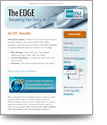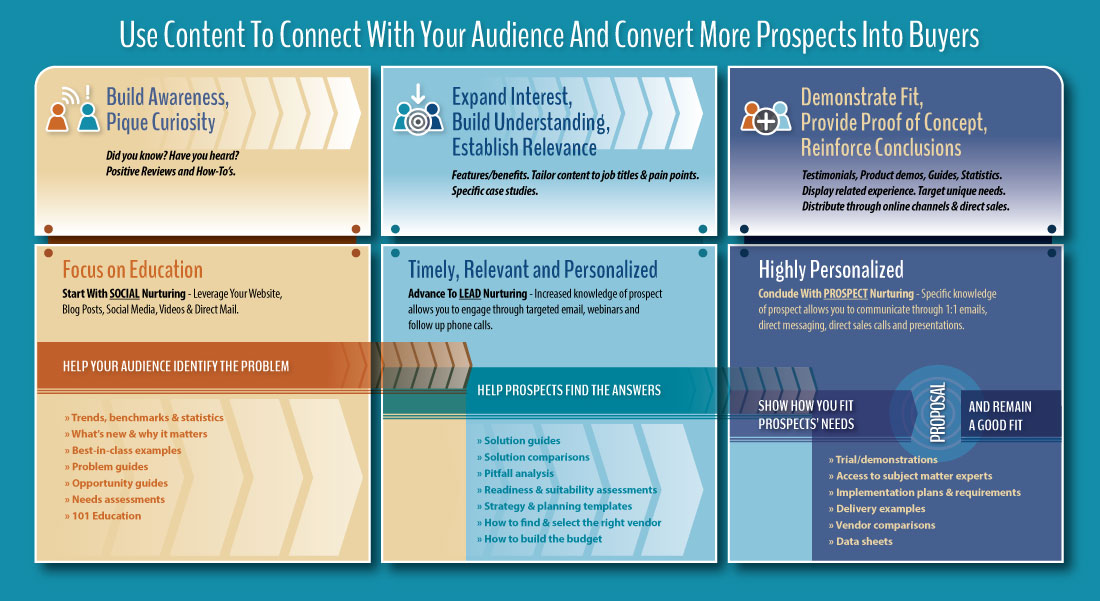Content. A crucial element for all online channels.

If you develop content effectively, it will help you capture new prospects and escort them through the buyers journey. Without it, you miss opportunities.
But developing content can be daunting. Identifying the topics. Writing the copy. Maintaining the frequency. Unless it's your only job, it's challenging just to find time for the writing. How do you consistently handle the other details?
But there are ways to take information, contained throughout your company, and use it to develop content for online channels.
You Have More Content Than You Think
Organizations produce large amounts of information for various end users. Sales presentations, employee training, industry events and community initiatives are just a few responsibilities various members of your team execute throughout the year. Whether it's a slide deck or written report, there's intelligence you can use.
Take that information and use it to develop content for online distribution.
1 | Collect Materials
Although there's overlap in the type of information that's produced in each area, look to collect as many relevant materials as possible. Here are just a few of the possibilities:
- Brochures
- Sell Sheets
- Catalogs
- Presentations
- Past Webinars
- Case Studies
- RFP Responses
Employee Facing Materials
- Internal training materials
- New employee orientation
- Employee presentations
- Sales meeting presentations
- Recruiting presentations
- Instructional videos
- Employee newsletters
- Annual Reports
- Investor/Board presentations
- Certification information
- Association information
- Strategic plans
- News releases
- Community benefit reports
- Presentations in the community
- Charitable giving reports
2 | Make Three Buckets
- Education
- Build Understanding and Relevance
- Demonstrate Fit and Provide Proof of Concept
As prospects progress through the purchasing stages, they benefit from different types of content.
- For prospects in the top of the funnel. As they start learning about you or a need you can potentially help solve - it's Education
- For prospects in the middle of the funnel. As they get to know you and need more specifics on your solutions - it's Building Understanding and Relevance
- For prospects in the bottom of the funnel. As they consider your solution - it's Demonstrating Fit and Providing Proof of Concept
3 | Pick The Right Bucket
Once you determine the topics that have potential, how do you use them?
- Training Materials - are intended for internal employee training. But, can some information be repurposed to assist the education of a new prospect?
- Association Trend Information - helps you determine where to invest your resources. Are some of the statistics relevant to a prospect just learning about your industry?
- Brochures - are used as a selling tool. Can you take feature/advantage/benefit statements to increase audience understanding?
- Employee Presentations - often discuss a companies value proposition. Use relevant slides to increase audience understanding of your solutions.
- Case Studies - help customers understand the value of your offering. Online it helps you demonstrate why you are a good fit.
- RFPs - are a necessary part of closing some deals. Use an implementation plan to make prospects feel comfortable with your solution.
4 | Repurpose And Develop Content For Your Online Channels
A slide with bullet points. A brochure with too much "fluff." Information for internal use. The content you gathered isn't plug and play. But, it should provide plenty of ideas.
Using a mix of content in multiple online channels connects you to the broadest audience. Evaluate the information and determine how to build it out.
- People love statistics and facts. Pull out applicable information and turn it into a "Statistics That Impact Your Business" article.
- Your target audience self educates online. Take industry trend information and make it a downloadable white paper to capture interested prospects.
- DIY is in. Turn training information into a "how you can do it yourself" blog post. Although a few readers may do it themselves, most will look to you for help.
- Connecting on a personal level is important. Take an image and a small section of the community benefits report and upload on Facebook.
Developing content is no easy task. But using viable information from internal sources will help you identify and topics that simplify the process.
Need help with your content strategy? Download the Content Tool Set.



 Insight Delivered Directly to You Interesting topics, great offers and free marketing tools.
Insight Delivered Directly to You Interesting topics, great offers and free marketing tools.

